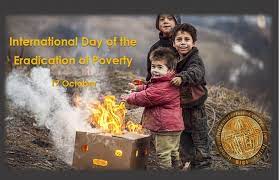Courtesy : en.wikipedia.org
Eradicating poverty
Poverty reduction, poverty relief, or poverty alleviation, is a set of measures, both economic and humanitarian, that are intended to permanently lift people out of poverty.
Measures, like those promoted by Henry George in his economics classic Progress and Poverty, are those that raise, or are intended to raise, ways of enabling the poor to create wealth for themselves as a conduit of ending poverty forever. In modern times, various economists within the Georgism movement propose measures like the land value tax to enhance access to the natural world for all. Poverty occurs in both developing countries and developed countries. While poverty is much more widespread in developing countries, both types of countries undertake poverty reduction measures.
Poverty has been historically accepted in some parts of the world as inevitable as non-industrialized economies produced very little, while populations grew almost as fast, making wealth scarce. Geoffrey Parker wrote that:
Poverty reduction occurs largely as a result of overall economic growth. Food shortages were common before modern agricultural technology and in places that lack them today, such as nitrogen fertilizers, pesticides and irrigation methods. The dawn of the Industrial Revolution led to high economic growth, eliminating mass poverty in what is now considered the developed world.World GDP per person quintupled during the 20th century. In 1820, 75% of humanity lived on less than a dollar a day, while in 2001 only about 20% did.
Today, continued economic development is constrained by the lack of economic freedoms. Economic liberalization requires extending property rights to the poor, especially to land. Financial services, notably savings, can be made accessible to the poor through technology, such as mobile banking.Inefficient institutions, corruption, and political instability can also discourage investment. Aid and government support in health, education, and infrastructure helps growth by increasing human and physical capital.
Economic liberalization
Proponents of economic liberalization have argued that it reduces poverty.Other commentators have claimed that, due to economic liberalization, poverty in the world is rising rather than declining, and the data provided by the World Bank, echoing that poverty is decreasing, is flawed.They also argue that extending property rights protection to the poor is one of the most important poverty reduction strategies a nation can implement. Securing property rigts to land, the largest asset for most societies, is vital to their economic freedom.The World Bank concludes that increasing land rights is ‘the key to reducing poverty’ citing that land rights greatly increase poor people’s wealth, in some cases doubling it. It is estimated that state recognition of the property of the poor would give them assets worth 40 times all the foreign aid since 1945.Although approaches varied, the World Bank said the key issues were security of tenure and ensuring land transactions were low cost. In China and India, noted reductions in poverty in recent decades have occurred mostly as a result of the abandonment of collective farming in China and the cutting of government red tape in India.
New enterprises and foreign investment can be driven away by the results of inefficient institutions, corruption, the weak rule of law and excessive bureaucratic burdens. It takes two days, two bureaucratic procedures, and $280 to open a business in Canada while an entrepreneur in Bolivia must pay $2,696 in fees, wait 82 business days, and go through 20 procedures to do the same.Such costly barriers favor big firms at the expense of small enterprises where most jobs are created.In India before economic reforms, businesses had to bribe government officials even for routine activities, which was in effect a tax on business.
However, the free market principle of ending government sponsorship of social programs has also had negative consequences. For example, the World Bank presses poor nations to eliminate subsidies for fertilizer that many farmers cannot afford at market prices. The reconfiguration of public financing in former Soviet states during their transition to a market economy called for reduced spending on health and education, sharply increasing poverty.
Trade liberalization increases total surplus of trading nations. Remittances sent to poor countries, such as India, are sometimes larger than foreign direct investment and total remittances are more than double aid flows from OECD countries. Foreign investment and export industries helped fuel the economic expansion of fast growing Asian nations.However, trade rules are often unfair as they block access to richer nations’ markets and ban poorer nations from supporting their industrial Processed products from poorer nations, in contrast to raw materials, get vastly higher tariffs at richer nations’ ports. A University of Toronto study found the dropping of duty charges on thousands of products from African nations because of the African Growth and Opportunity Act was directly responsible for a “surprisingly large” increase in imports from Africa. Deals can sometimes be negotiated to favor the developing country such as in China, where laws compel foreign multinationals to train their future Chinese competitors in strategic industries and render themselves redundant in the long term. In Thailand, the 51 percent rule compels multinational corporations starting operations in Thailand give 51 percent control to a Thai company in a joint venture.Additionally, the United Nations Sustainable Development Goal advocates respect for countries leadership to implement policies for poverty eradication and sustainable development.
Reversing wealth concentration
Oxfam, among others, has called for an international movement to end extreme wealth concentration arguing that the concentration of resources in the hands of the top 1% depresses economic activity and makes life harder for everyone else—particularly those at the bottom of the economic ladder. And they say that the gains of the world’s billionaires in 2017, which amounted to $762 billion, were enough to end extreme global poverty seven times over.





